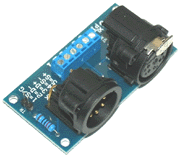The small RGB led light thread and using TRS connector and if there were support for it in the standards. It is not what I want to discuss here, I would like some more info on something that were lightly touched in that thread but I believe it is OT(in that thread) so I started this thread for it.
How should you wire the DMX throu connection and how is it done in commercial fixtures? High and low end?
If I for some reason need a one channel dmx relay, don't have one lying around and are on a thight budget. I might build something like this: Velleman nv which is a kit costing around 30€, but it only got a DMX in and not a throu.
How should it be done? What does the standard say and how is it most often done?
A female XLR in parallel with the board?
How should you wire the DMX throu connection and how is it done in commercial fixtures? High and low end?
If I for some reason need a one channel dmx relay, don't have one lying around and are on a thight budget. I might build something like this: Velleman nv which is a kit costing around 30€, but it only got a DMX in and not a throu.
How should it be done? What does the standard say and how is it most often done?
A female XLR in parallel with the board?



